What is hydroelectricity?
According to the National Geographic Society, hydroelectricity is ‘a form of renewable energy that uses the power of moving water to generate electricity. Producing hydroelectricity usually involves a reservoir of water. Reservoirs are often created using a dam to control water flow as it moves downhill. The flow of the water downhill can be used to turn the blades of a turbine, which then generates electricity.
Hydroelectricity is a renewable energy source. This means it is not produced by burning the world’s limited coal, oil, and gas supplies. It is also a greener way of producing energy. Hydroelectricity does not involve burning fossil fuels, which releases the carbon dioxide responsible for global warming.
What is the Grand Ethiopian Renaissance Dam?
‘The Grand Ethiopian Renaissance Dam is a hydropower plant built in Ethiopia on the Nile River. Construction on the multibillion-dollar project began in 2011. It opened in 2020 and started producing electricity on Sunday 20th February 2022.
Prime Minister Abiy Ahmed, hopes that it will bring electricity to 60% of Ethiopia’s population, who currently live without it. It is projected to operate at more than 5000 megawatts of electricity. This would be more than double Ethiopia’s current output.
The dam project is intended to help resolve the current electricity deficit the country faces. If a country has an electricity deficit, then electricity demand is greater than the amount of energy available or being produced. In Ethiopia, this means electricity shortcuts are a common occurrence. The hydroelectric dam aims to improve this situation.
The controversy surrounding the dam
However, there are concerns from countries north of the dam, along the river Nile. Both Egypt and Sudan have commented on the dam posing a potential threat. Egypt relies on the Nile to irrigate its crops and provide drinking water. Sudan worries that its dams might be negatively impacted by this project. As the dam will retain large quantities of water, the flow downstream might be reduced. This might result in a shallower river downstream and a potential water shortage for Egypt and Sudan.
Will an agreement about the dam be reached?
In 2010, the Agreement on the Nile Basin Cooperative Framework was made. Today this includes ten countries: Burundi, DR Congo, Egypt, Ethiopia, Kenya, Rwanda, South Sudan, Sudan, Tanzania, and Uganda.
The agreement aimed to ‘protect, conserve’ and ‘utilize the water resources of the Nile River System in an equitable and reasonable manner.’ As per the agreement, cooperation will be necessary to reach an agreement about Ethiopia’s dam project. This agreement should be fair to all the stakeholders involved with the management of the Nile River.
Conclusion
As the world shifts towards using more renewable energy, hydroelectricity is an incredibly important source of energy. It has the potential to help millions of lives, assisting development in several countries. For example, in Ethiopia, electricity shortages can be solved by projects such as the Grand Ethiopian Renaissance Dam. However, there may be potential hurdles arising from mega-dam projects. These hurdles can be navigated with good international cooperation, especially across the river delta.

